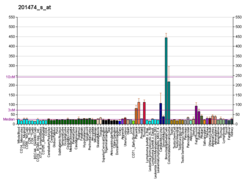| ITGA3 |
|---|
|
| Identifiers |
|---|
| Aliases | ITGA3, CD49C, GAP-B3, GAPB3, ILNEB, MSK18, VCA-2, VL3A, VLA3a, FRP-2, integrin subunit alpha 3, JEB7 |
|---|
| External IDs | OMIM: 605025; MGI: 96602; HomoloGene: 21129; GeneCards: ITGA3; OMA:ITGA3 - orthologs |
|---|
| Gene location (Human) |
|---|
 | | Chr. | Chromosome 17 (human)[1] |
|---|
| | Band | 17q21.33 | Start | 50,055,968 bp[1] |
|---|
| End | 50,090,481 bp[1] |
|---|
|
| Gene location (Mouse) |
|---|
 | | Chr. | Chromosome 11 (mouse)[2] |
|---|
| | Band | 11 D|11 59.01 cM | Start | 94,935,300 bp[2] |
|---|
| End | 94,967,627 bp[2] |
|---|
|
| RNA expression pattern |
|---|
| Bgee | | Human | Mouse (ortholog) |
|---|
| Top expressed in | - metanephric glomerulus
- right coronary artery
- upper lobe of left lung
- Descending thoracic aorta
- popliteal artery
- tibial arteries
- right lung
- right lobe of thyroid gland
- ascending aorta
- left lobe of thyroid gland
|
| | Top expressed in | - genital tubercle
- lumbar spinal ganglion
- decidua
- tail of embryo
- corneal stroma
- yolk sac
- crypt of lieberkuhn of small intestine
- right lung lobe
- epithelium of lens
- ileum
|
| | More reference expression data |
|
|---|
| BioGPS |  | | More reference expression data |
|
|---|
|
| Gene ontology |
|---|
| Molecular function | - metal ion binding
- protein domain specific binding
- laminin binding
- collagen binding
- protease binding
- protein heterodimerization activity
- integrin binding
- fibronectin binding
- protein binding
| | Cellular component | - extracellular exosome
- synapse
- integral component of membrane
- cell projection
- cell periphery
- cell junction
- growth cone
- membrane
- focal adhesion
- cell surface
- receptor complex
- synaptic membrane
- perinuclear region of cytoplasm
- excitatory synapse
- integrin complex
- basolateral plasma membrane
- filopodium membrane
- external side of plasma membrane
- integrin alpha3-beta1 complex
- plasma membrane
- growth cone filopodium
| | Biological process | - positive regulation of neuron projection development
- extracellular matrix organization
- lung development
- mesodermal cell differentiation
- skin development
- maternal process involved in female pregnancy
- cell-matrix adhesion
- negative regulation of cell projection organization
- positive regulation of cell-substrate adhesion
- heart development
- dendritic spine maintenance
- positive regulation of gene expression
- nephron development
- memory
- integrin-mediated signaling pathway
- response to gonadotropin
- leukocyte migration
- renal filtration
- regulation of transforming growth factor beta receptor signaling pathway
- regulation of Wnt signaling pathway
- regulation of BMP signaling pathway
- negative regulation of Rho protein signal transduction
- exploration behavior
- positive regulation of epithelial cell migration
- neuron migration
- cell adhesion
- positive regulation of protein localization to plasma membrane
| | Sources:Amigo / QuickGO |
|
| Orthologs |
|---|
| Species | Human | Mouse |
|---|
| Entrez | | |
|---|
| Ensembl | | |
|---|
| UniProt | | |
|---|
| RefSeq (mRNA) | | |
|---|
NM_013565
NM_001306071
NM_001306162 |
|
|---|
| RefSeq (protein) | | |
|---|
NP_001293000
NP_001293091
NP_038593 |
|
|---|
| Location (UCSC) | Chr 17: 50.06 – 50.09 Mb | Chr 11: 94.94 – 94.97 Mb |
|---|
| PubMed search | [3] | [4] |
|---|
|
| Wikidata |
| View/Edit Human | View/Edit Mouse |
|


















